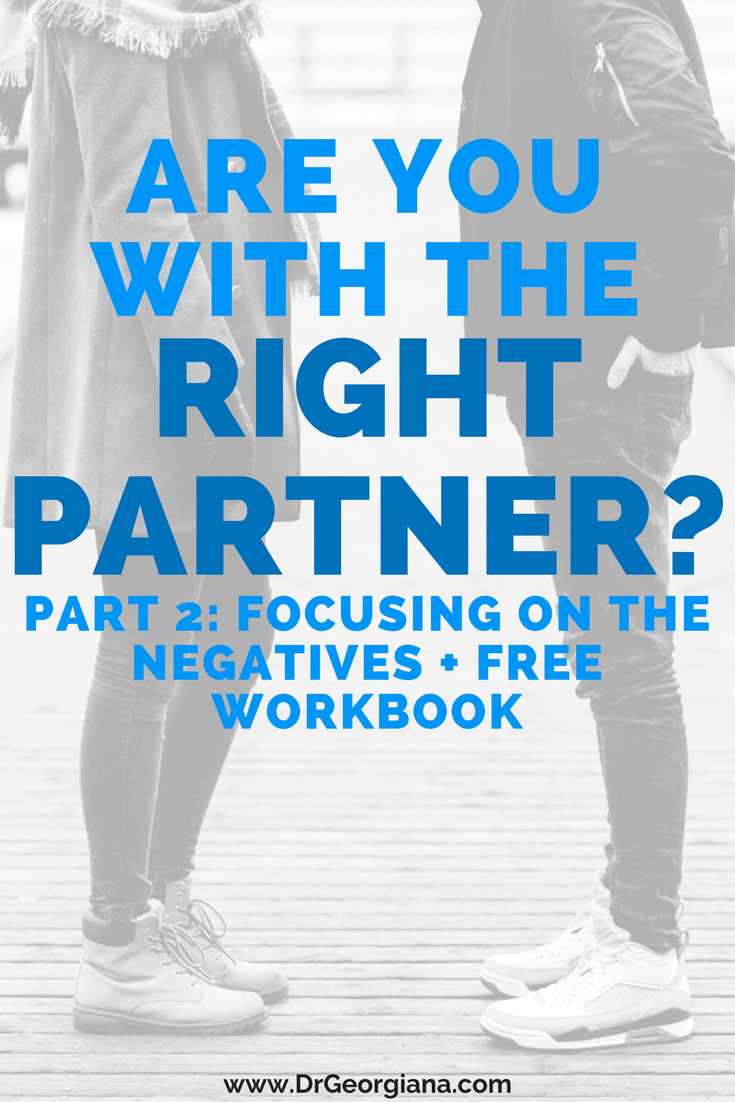If you started your journey with me in Part 1 of this series, we established that deciding whether to keep or leave a partner is an extremely difficult experience that has huge implications, emotionally, physically and economically.
Whether you have been struggling with whether your partner is right for you for the first time or the tenth time, you know that you have to get to the bottom of it and make a decision. Not knowing is excruciating and can take over every minute of your life. Instead of having fun with your friends and family, you are hiding your struggle, and doubting yourself It may even make you feel tense, insecure, afraid, or depressed.
My goal is to help erase your fear, eliminate uncertainty, ease your pain and give you the system that you need in order to make the right decision. Because that is what it is all about: making the right decision for you and following through with it.
With this system, you will have more clarity about who your partner really is, a deeper understanding of what is working and what is not, a clear map to deal with your doubt, and the tools necessary to follow through on whatever you decide to do.
In Part 1 of this series, you learned why feelings cannot be the only basis for making the decision of whether to keep or leave your partner.
Removing your feelings and looking at your partner in an objective way is difficult. If you are having trouble doing this, know that it will get easier as you learn more about yourself and your partner as we continue through the process.
In this post, I will explain why focusing on positive traits and behaviors in your partner rather than on negative ones is a mistake and the two reasons why focusing on the negatives is more likely to lead you to the right decision.
Rachel’s Story
Let me tell you the story of Rachel, a 40-year-old professional woman who had been in a committed relationship for 2 years. When she met her boyfriend James at a holiday party, she was struck by some of his great qualities.
Rachel appreciated James’ ability to connect with people and his willingness to listen. After dating for six months, Rachel and James moved in together and suddenly things changed. She began to notice peculiar behaviors in him, like being flirty with women. And when they had disagreements, James would keep quiet—not saying much at all. Even when Rachel got overly demanding, James rarely spoke his mind.
Although Rachel founds his behavior unusual, she interpreted his quiet nature at home and his social behavior in public as charming and interesting; especially because Rachel’s friends enjoyed his company and never said a negative word about him.
What James was doing, whether consciously or not, was behaving differently with Rachel in private. And since Rachel’s friends had nothing bad to say about James, Rachel disregarded his shortcomings.
Over time, however, James became even quieter with Rachel and more interested in socializing with strangers than with her.
One day, one of Rachel’s friends told her about these “passive-aggressive behaviors” in people that she has been learning about. When her friend explained how passive-aggressive people behave, Rachel realized that this accurately described James.
By now, Rachel’s intuition was starting to send her very strong signals. But she was still willing to overlook that because she believed that James’s positive qualities were more important than his negative traits, so she swept anything negative about him under the rug.
Fast forward one year: James was in and out of the house and Rachel often wondered where he goes. Eventually, Rachel realized that the woman next door had stopped talking to her and made a point to avoid her.
A few months later, Rachel discovered James and the neighbor fooling around in a shed by her house. She was devastated. After several previous red flags, Rachel finally started to ask herself how she could have focused on James’s positive qualities and disregarded his negative traits….
Rachel ended up leaving James and spent some time figuring out why the positive traits in her partner meant so much more to her than the negative traits she knew he had. This experience opened her eyes to the fact that she had two prior relationships that fail and was afraid of being alone. She overlooked the obvious to save herself from her underlying fear…
Negative Traits
After hearing Rachel’s story, you may think that you would never do what she did. But I encourage you to withhold judgment because hindsight is 20/20.
Think back in your life, how many times did you overlook negative traits in a partner? And how many times did you blow your partner’s qualities out of proportion and then realized some limitations that were there all along?
You and Rachel are not alone.
We have all done it at one point or another because we’ve been taught to “stay positive” and because positive qualities are not as scary to look at, so we’re quicker to trust them.
When we see qualities in a partner, two things usually happen:
- We idealize. When we feel attracted to someone and love them, we engage in “wishful thinking.” Our desire to feel good and in love blinds us. We see the positive traits and behaviors in that person, justify the negative ones and lose our objectivity. Obviously, this presents a problem as you need to have a clear picture of who the person you are spending the rest of your life with really is, before you can free yourself from the relationship if they have traits or behaviors that are going to make you miserable.
- The second thing that happens when we see qualities in a partner is that we tend to allocate traits and behaviors to our partner that were found in a positive childhood caregiver and deny anything that interferes with that projection.
This is not just a theory. It’s rooted in human behavior, and I’ve seen it validated countless times in my 20-year career.
For example, if your parents were faithful to each other, you may tend to disregard any evidence that your partner is being unfaithful, as Rachel did.
After doing some soul searching, Rachel realized that she was not only projecting this quality from her parents onto her partner, but she also idealized him by assuming that James did not contest her demands because he was “easy going” and agreeable. When in reality James was not expressing his true feelings and became resentful of her.
It was a painful lesson for Rachel, as it would be for you if you did not try to get past the positive qualities of your current partner to look closely at their negative traits and behaviors.
The next step in deciding whether to stay or leave your partner is to do the following 4 things:
- Make a list of your partner’s most prominent positive
- Ask yourself whether you are idealizing your partner and only seeing their positive traits and behaviors rather than their negative ones.
- Identify any projections you may have, such as wanting your partner to be like a parent, or the opposite of one, as these are powerful forces that can prevent you from seeing who your partner really This may require you to dig deep within yourself because these projections tend to remain beneath the surface of our awareness.
- Review your partner’s most prominent positive traits in light of what you have discovered about yourself. Namely, any projections or idealizations that you may have that may make you see more qualities in your partner than are actually
For example, if you originally thought that your partner was very kind, but then realized that you were projecting onto him or her qualities your father had, you should examine your partner’s level of kindness again and ask yourself if they are as kind as you originally thought.
You can download a simple workbook I’ve setup for you to complete this exercise by clicking the button below.
As you complete this exercise, please leave your questions and comments below. I look forward to answering your questions and reading about your progress.
Don’t forget to return for parts 3 and 4, which I will link below. In the next segment, we will explore whether or not you partner’s negative traits and behaviors fit with you or not. These are not extreme traits or behaviors, but ones that you dislike. In part 4, we will look at traits and behaviors in your partner that may be harmful or dangerous to you or anyone else.
Part 4: Evaluating Unhealthy Traits and Behaviors
Before then, make sure that you to complete the exercises in the workbook so that you are ready to take the next step in the process.

